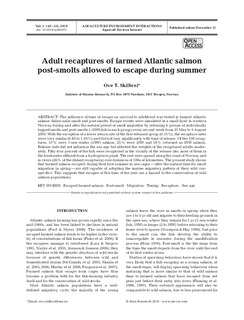| dc.contributor.author | Skilbrei, Ove | |
| dc.date.accessioned | 2011-03-04T15:11:17Z | |
| dc.date.available | 2011-03-04T15:11:17Z | |
| dc.date.issued | 2010-12-21 | |
| dc.identifier.issn | 1869-215X | |
| dc.identifier.issn | 1869-7534 | |
| dc.identifier.uri | http://hdl.handle.net/11250/117036 | |
| dc.description.abstract | The influence of time of escape on survival to adulthood was tested in farmed Atlantic salmon Salmo salar smolt and post-smolts. Escape events were simulated in a small fjord in western Norway during and after the natural period of smolt migration by releasing 6 groups of individually tagged smolts and post-smolts (~2000 fish in each group) every second week from 27 May to 5 August 2005. With the exception of a lower return rate of the first released group (0.31%), the recapture rates were very similar (0.85 to 1.05%) and did not vary significantly with time of release. Of the 100 recaptures, 57% were 1-sea-winter (1SW) salmon, 25% were 2SW and 18% returned as 3SW salmon. Release date did not influence the sea age but affected the weights of the recaptured adults moderately. Fifty-four percent of the fish were recaptured in the vicinity of the release site, most of them in the freshwater effluent from a hydropower plant. The rest were spread along the coast of Norway and in rivers (26% of the distant recaptures) over distances of 100s of kilometres. The present study shows that farmed salmon escaped during their first summer in sea cages—after the natural time for smolt migration in spring—are still capable of adopting the marine migratory pattern of their wild conspecifics. This suggests that escapes at this time of the year are a hazard to the conservation of wild salmon populations. | en_US |
| dc.language.iso | eng | en_US |
| dc.publisher | Inter Research | en_US |
| dc.subject | farmed fish escape | en_US |
| dc.subject | fiskerømning | en_US |
| dc.subject | migration patterns | en_US |
| dc.subject | vandringsmønster | en_US |
| dc.subject | recapture | en_US |
| dc.subject | gjenfangst | en_US |
| dc.title | Adult recaptures of farmed Atlantic salmon post-smolts allowed to escape during summer | en_US |
| dc.type | Journal article | en_US |
| dc.type | Peer reviewed | en_US |
| dc.subject.nsi | VDP::Agriculture and fishery disciplines: 900::Fisheries science: 920::Aquaculture: 922 | en_US |
| dc.source.pagenumber | 147-153 | en_US |
| dc.source.volume | 1 | |
| dc.source.journal | Aquaculture Environment Interactions | |
| dc.source.issue | 2 | |
| dc.identifier.doi | http://dx.doi.org/10.3354/aei00017 | |
